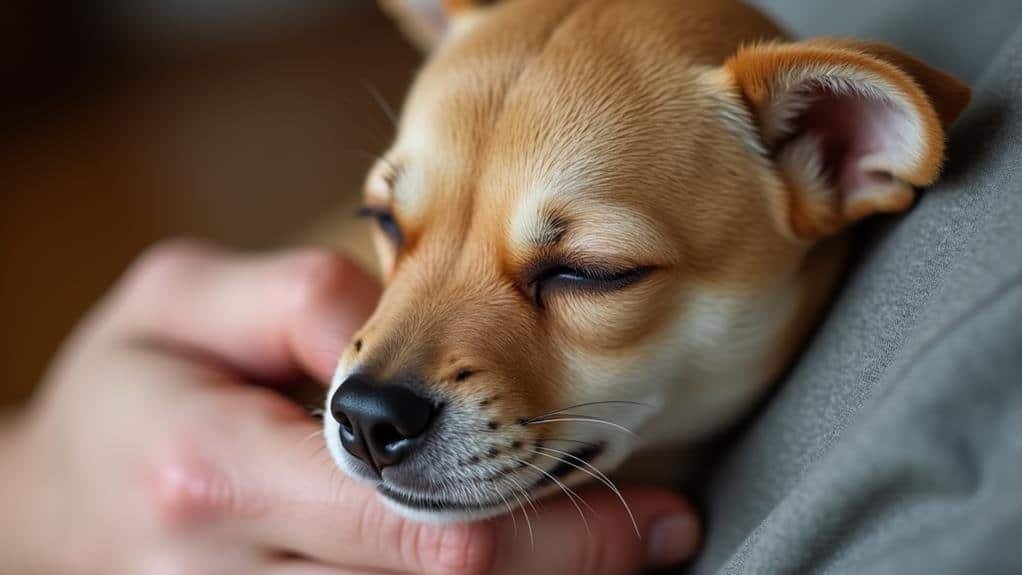Your dog's head-burying behavior is a sign of deep affection and trust. It's a way for your furry friend to seek comfort, attention, and emotional support from you. This gesture stems from instinctual behaviors inherited from their wolf ancestors and serves multiple purposes. It helps your dog feel secure, mark you with their scent, and strengthen your bond. Sometimes, it can also indicate anxiety or stress relief. Each dog's personality influences how often they exhibit this behavior. Understanding the reasons behind this endearing habit can help you better respond to your dog's emotional needs and deepen your connection.
Trust and Comfort
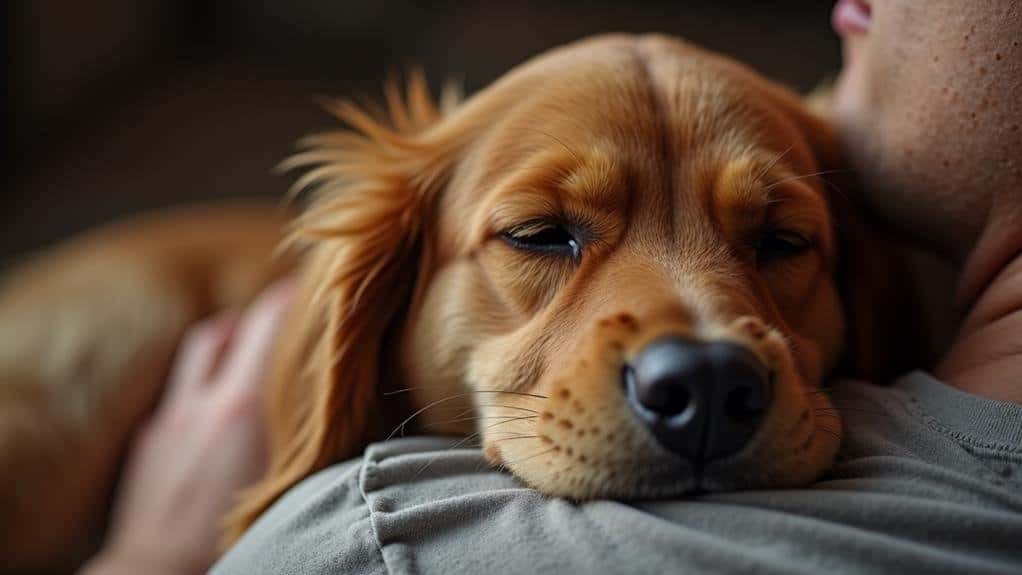
When your dog buries his head into you, it's a powerful display of trust and comfort. This behavior indicates that your furry friend feels safe and secure in your presence. By exposing their vulnerable position, your dog is demonstrating their confidence in you as their protector and source of emotional support.
Head burying serves as a refuge for your canine companion during stressful situations. It's their instinctive way of seeking safety and reassurance when faced with anxiety or fear. By allowing your dog to engage in this behavior, you're providing them with the emotional comfort they need to feel secure.
This gesture goes beyond mere physical contact; it's a way for your dog to deepen their bond with you. When they bury their head, they're expressing their love and reliance on your support.
It's essential to recognize this as an opportunity to strengthen your relationship through mutual trust.
Understanding the context of head burying helps you better respond to your dog's emotional needs. By acknowledging and reciprocating this affectionate gesture, you're reinforcing the trust your dog has placed in you and fostering a stronger human-canine connection.
Seeking Attention and Affection
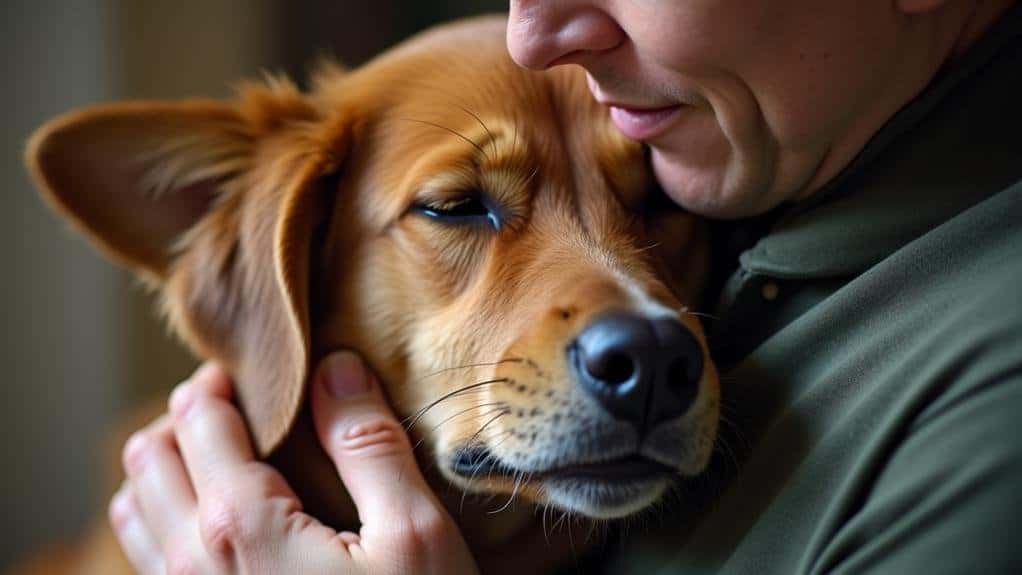
Beyond seeking comfort and security, your dog's head-burying behavior often serves as a powerful tool for gaining attention and affection. When your furry friend buries their head into you, they're fundamentally saying, "Hey, I'm here, and I want to interact with you!" This gesture is a clear sign that your dog craves your attention and seeks to reinforce the bond between you.
If you've been busy or distracted, your dog may use this behavior to remind you of their presence and desire for interaction. By burying their head, they're initiating physical contact and expressing their affection in a way that's hard to ignore. Your positive response, such as petting or speaking affectionately, reinforces this behavior and encourages your dog to repeat it in the future.
This head-burying action isn't just about getting your attention; it's also a way for your dog to receive affection. When you respond with love and care, you're fulfilling their emotional needs and strengthening your bond.
Instinctual Behavior From Ancestry
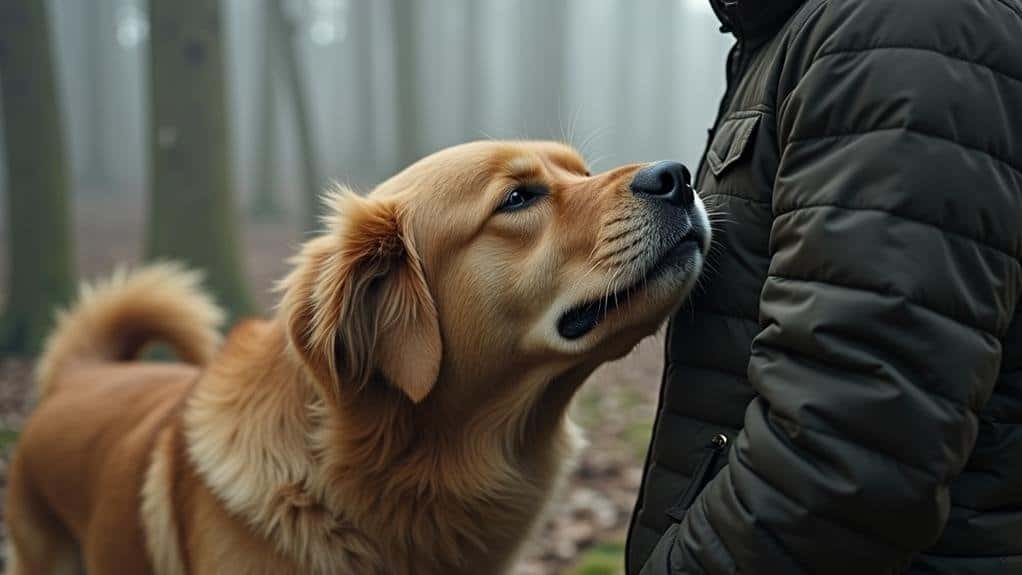
Frequently, your dog's head-burying behavior stems from deeply ingrained instincts inherited from their wolf ancestors. This instinctual behavior reflects your pet's need for security and comfort, mirroring the actions of wild canines seeking refuge in their den or huddling close to pack members during stressful situations.
When your dog buries their head into you, they're tapping into residual instincts from their evolutionary past. This behavior can be traced back to ancestral traits where physical closeness provided warmth and protection within a pack.
By understanding these instinctual behaviors, you can better appreciate your dog's actions and respond effectively to their emotional needs.
The head-burying gesture serves multiple purposes rooted in your dog's ancestry:
- Seeking physical comfort and warmth
- Expressing a need for security in times of stress or anxiety
- Reinforcing social bonds within their "pack" (you and your family)
Scent Marking and Familiarity
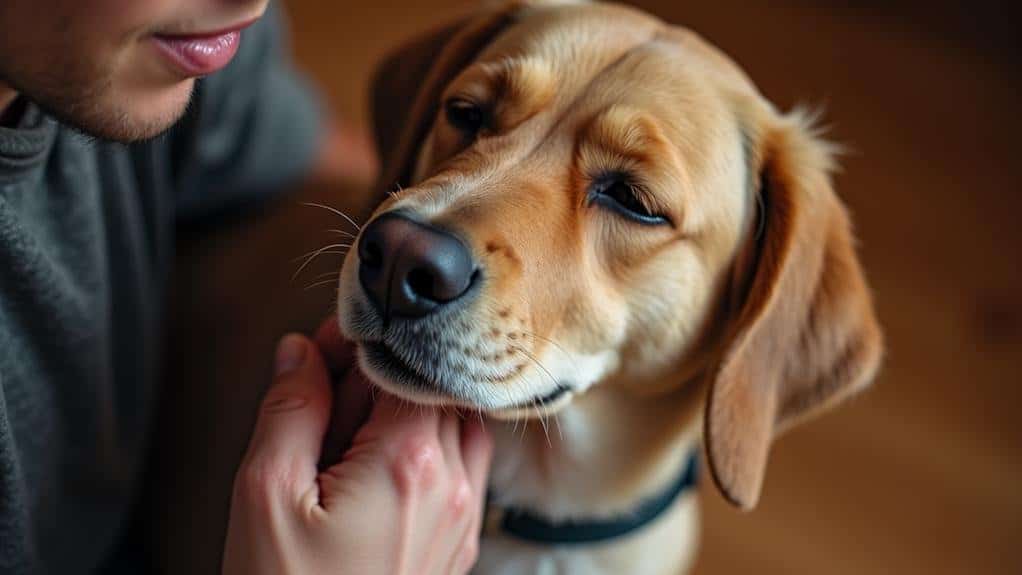
A significant factor in your dog's head-burying behavior is their remarkable sense of smell. When your furry friend nuzzles into you, they're immersing themselves in your unique scent, which plays an important role in their comfort and emotional attachment to you.
This behavior serves multiple purposes. First, it's a form of scent marking, where your dog subtly claims you as part of their territory. By pressing close to you, they're leaving their own scent while absorbing yours, reinforcing their bond with you.
Additionally, your familiar scent provides a sense of security for your dog. Your smell is associated with safety, comfort, and positive experiences, helping to alleviate any anxiety they may feel.
The act of burying their head into you allows your dog to fully integrate your scent into their sensory experience. This enhances their feelings of belonging and connection to you.
Emotional Support and Security
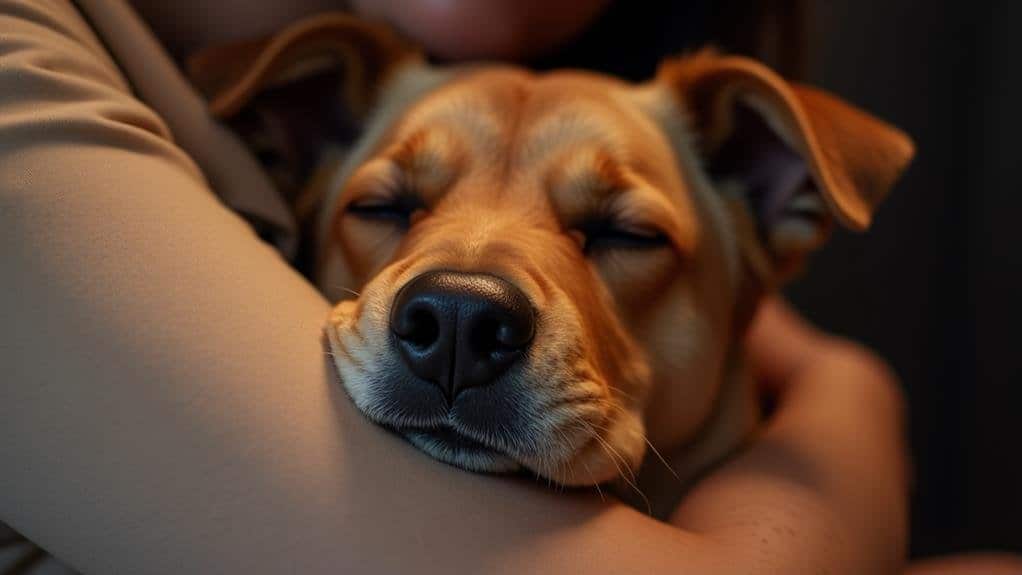
When your dog buries their head into you, they're often reaching out for emotional support and security. This affectionate gesture serves as a self-soothing mechanism, reflecting your furry friend's innate need for comfort during stressful or anxious situations.
By seeking physical closeness, your dog is communicating their emotional reliance on you and reinforcing the bond of trust you've established together. This behavior stems from your dog's desire to feel safe and protected, reminiscent of pack behavior in the wild.
As their trusted companion, you're uniquely positioned to provide the comfort and reassurance they crave. By responding positively to this gesture, you can enhance your dog's sense of security and well-being, fostering a stronger human-canine connection.
To support your dog's emotional needs and strengthen your bond, consider:
- Offering gentle pets and soothing words when they seek closeness
- Creating a safe, calm environment during stressful situations
- Engaging in regular bonding activities to reinforce trust and affection
Understanding and responding to your dog's head-burying behavior can deepen your relationship, ensuring that you're meeting their emotional needs while providing the comfort and security they seek from their devoted human companion.
Playful Interaction
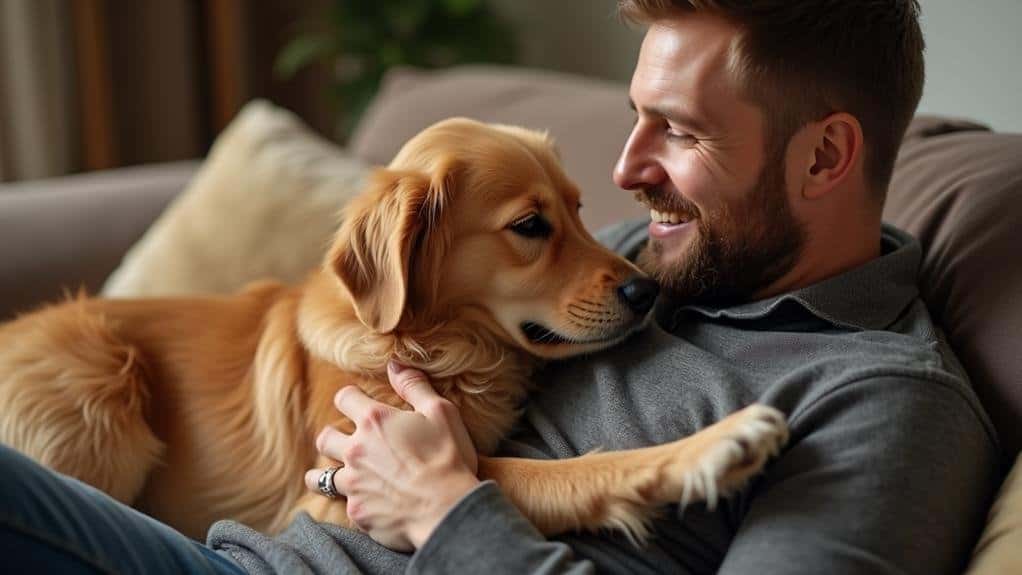
Beyond seeking emotional support, your dog's head-burying behavior can also signify a playful mood. When your furry friend nudges you with their head or buries it into you, they're often initiating a playful interaction. This behavior is a clear invitation for engagement and fun, especially when accompanied by a wagging tail and relaxed posture.
You'll notice this head nudging during playtime, signaling your dog's excitement and desire to start a game. It's their way of saying, "Let's play!"
If you've been busy and your dog feels neglected, they might resort to this attention-seeking behavior, along with light pawing or playful barking, to grab your focus.
It's important to distinguish between playful head-burying and anxious behavior. A relaxed demeanor indicates joy, while signs of stress suggest something else is at play.
Anxiety and Stress Relief
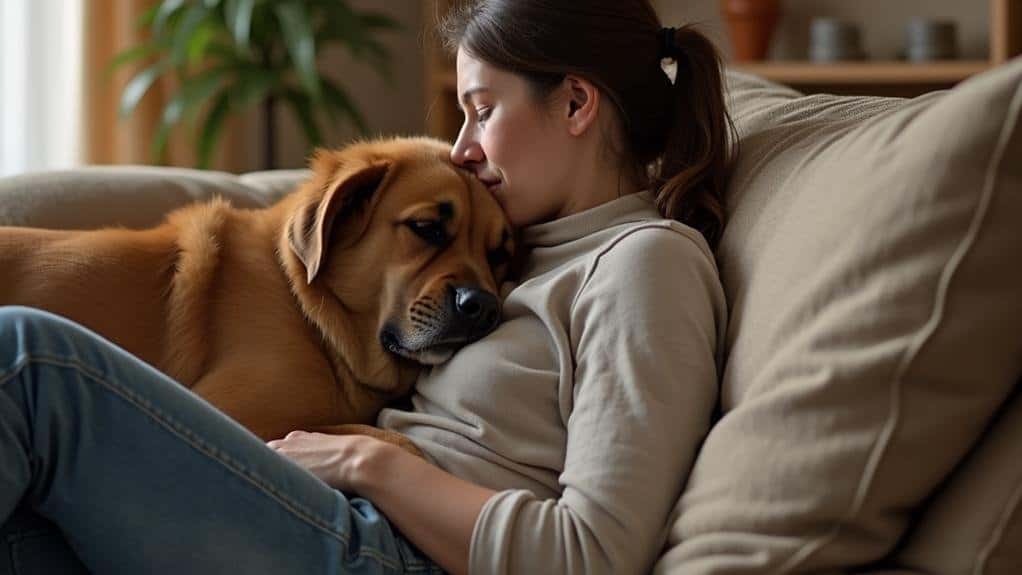
Have you ever noticed your dog burying their head into you during stressful situations? This behavior often serves as a coping mechanism for anxiety, providing your furry friend with a sense of comfort and safety.
It's reminiscent of puppies seeking closeness to their mothers for reassurance when they're feeling overwhelmed.
Your dog may be responding to various environmental stressors by seeking refuge in your presence. Common triggers include:
- Loud noises
- Unfamiliar surroundings
- Anticipation of being left alone
This head-burying gesture can also indicate separation anxiety, as your dog looks to you for emotional support when they sense you're about to leave.
By burying their head into you, they're fundamentally seeking a safe haven from their worries.
To help your dog feel more secure and reduce this behavior, focus on creating a calm environment.
Offer reassurance and positive reinforcement when they're relaxed.
As your dog learns to feel more at ease in various situations, you may notice a decrease in their head-burying behavior.
Individual Personality Differences

Just as humans have unique personalities, dogs display individual differences that influence their head-burying behavior. Your individual dog's tendency to bury its head into you can vary greatly based on its distinct personality and emotional needs.
Some dogs are naturally more affectionate and seek frequent physical contact, while others may prefer less intense interactions.
Breed characteristics can play a role, with typically affectionate breeds like Labradors and Golden Retrievers more likely to engage in head-burying. However, it's important to remember that each dog is unique, regardless of breed.
Age and upbringing also factor into this behavior, with younger dogs often seeking more reassurance through physical closeness.
To better understand your dog's communication style, observe its specific preferences for affection. Pay attention to how often and in what situations your dog engages in head-burying.
This personalized approach will help you interpret your pet's emotional state more accurately. Keep in mind that changes in this behavior over time may indicate shifts in your dog's comfort levels or emotional well-being, emphasizing the importance of ongoing observation and adaptation to your pet's individual needs.
Bonding and Relationship Strengthening
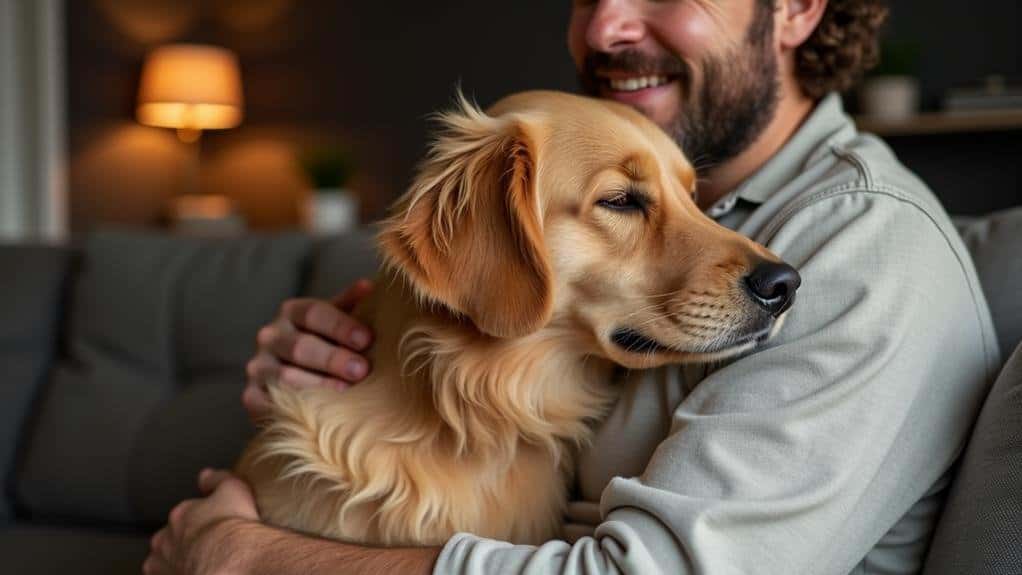
Strengthening the bond between you and your dog is a key function of head-burying behavior. When your furry friend nestles their head into you, they're expressing deep affection and trust, enhancing your emotional connection.
This tactile gesture serves as a powerful way for your dog to communicate their loyalty and love, while also seeking comfort and reassurance from you.
Head burying reflects your dog's instinctive need for closeness, mirroring pack behaviors seen in their wild ancestors. By engaging in this intimate act, your dog is reinforcing their reliance on you for emotional support, especially during stressful situations.
This behavior not only provides comfort to your pet but also strengthens your relationship through physical touch and proximity.
To further nurture this bond, consider:
- Responding positively with gentle praise and affection
- Creating a safe, calm environment for your dog to express this behavior
- Recognizing and respecting your dog's need for closeness
Managing Head Burying Behavior
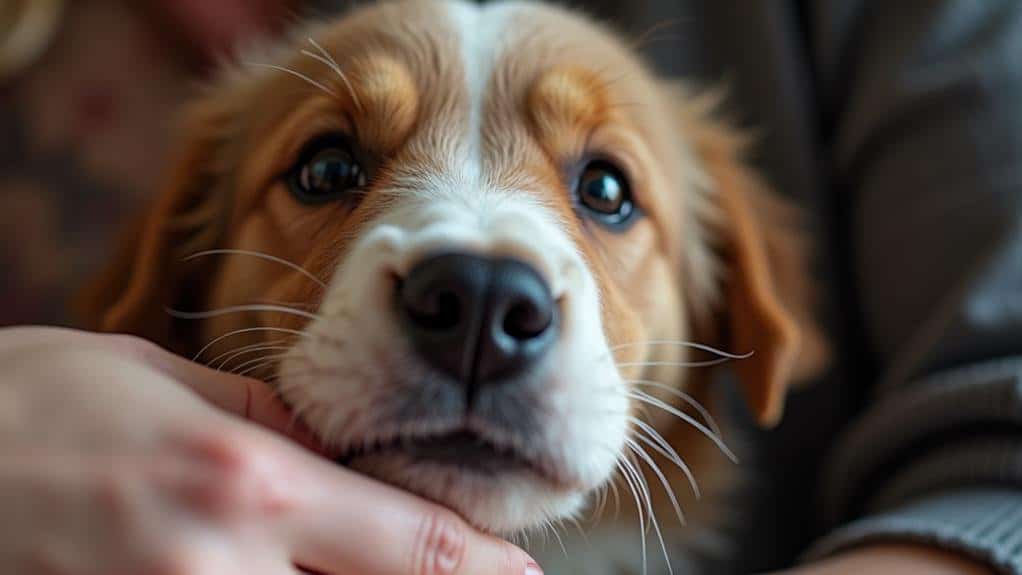
While head burying is a natural and often endearing behavior, there may be times when it becomes excessive or disruptive. If you notice your dog burying their head into you more frequently than usual, it's important to monitor the situation and determine if intervention is necessary.
To manage this behavior, gently redirect your dog's attention to toys or designated resting areas when head burying interferes with daily activities. Use calm and reassuring tones when addressing the behavior, as this promotes a sense of security for your furry friend.
Remember, your dog may be seeking comfort, so it's vital to reinforce positive interactions rather than scolding. Establish consistent routines and engage in regular playtime to help reduce anxiety, which can lessen your dog's need for head burying as a comfort mechanism.
Reward calm behavior with treats or affection to strengthen your bond and encourage positive interactions. By implementing these strategies, you'll be able to maintain a healthy relationship with your dog while managing excessive head burying.
Ultimately, the goal is to strike a balance between allowing this affectionate gesture and ensuring it doesn't become problematic.
Frequently Asked Questions
Why Does My Dog Bury Their Head Into Me?
Your dog's head-burying is a show of trust and affection. It's their way of seeking comfort and closeness. They're expressing vulnerability and looking for emotional support. It's also an instinctive behavior rooted in pack mentality for warmth and protection.
Why Does My Dog Nudge His Head Into Me?
Your dog nudges his head into you to seek affection and attention. It's a sign of love and trust, reinforcing your bond. This behavior can also indicate a desire to play or interact, expressing excitement and companionship.
Why Does My Dog Slam His Head Into Me?
Your dog slams his head into you as a playful gesture of affection and excitement. He's seeking attention, initiating interaction, or expressing trust. It's his way of communicating love and bonding with you physically. Watch his body language for context.
What Does It Mean When Your Dog Lays His Head on You?
When your dog lays his head on you, it's a sign of trust and affection. He's seeking warmth, security, and attention. It's also a way to communicate and bond with you, especially during stressful times.
Conclusion
You've now explored the various reasons behind your dog's head-burying behavior. Whether it's seeking comfort, showing affection, or relieving stress, this gesture is a sign of trust and bonding. Remember, each dog is unique, so pay attention to your pup's individual needs and personality. Embrace this endearing habit, but if it becomes excessive, don't hesitate to consult with your vet. Ultimately, your dog's head-burying is a heartwarming display of the special connection you share.

